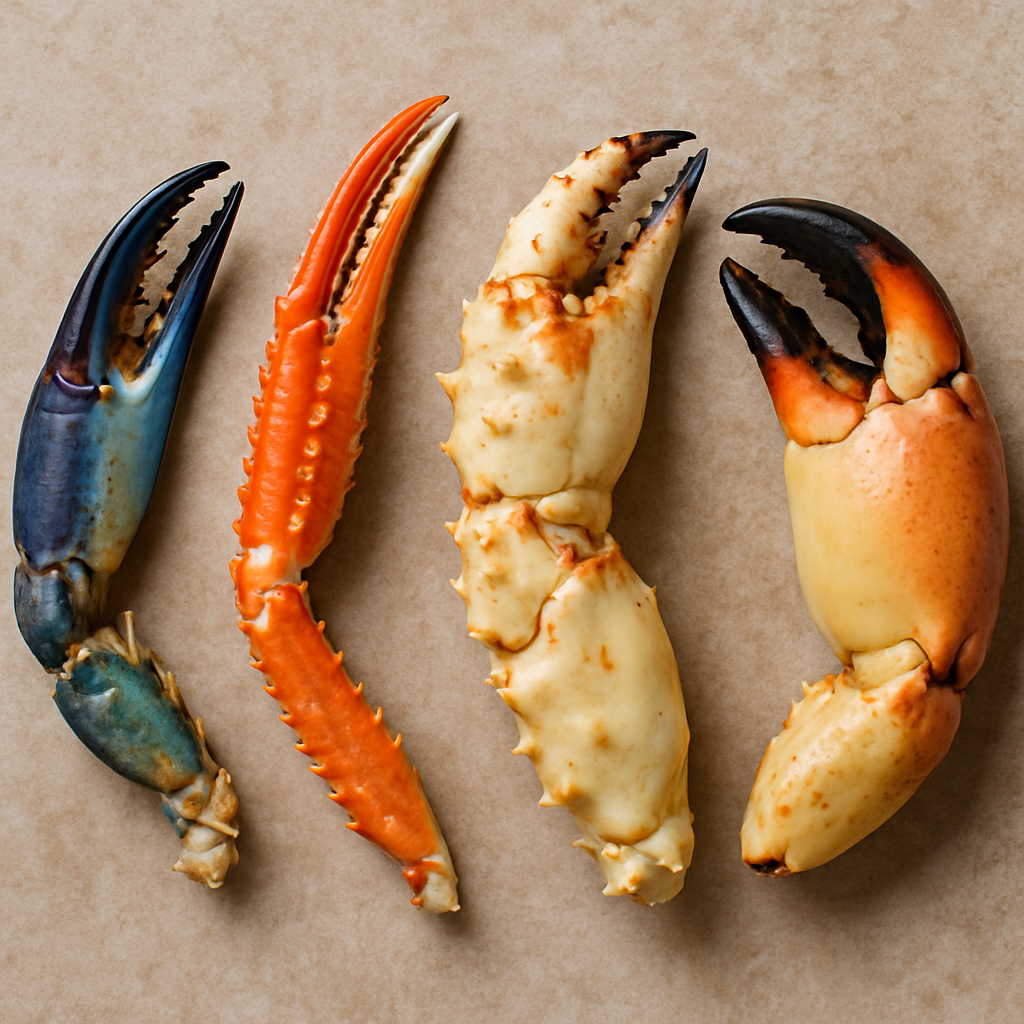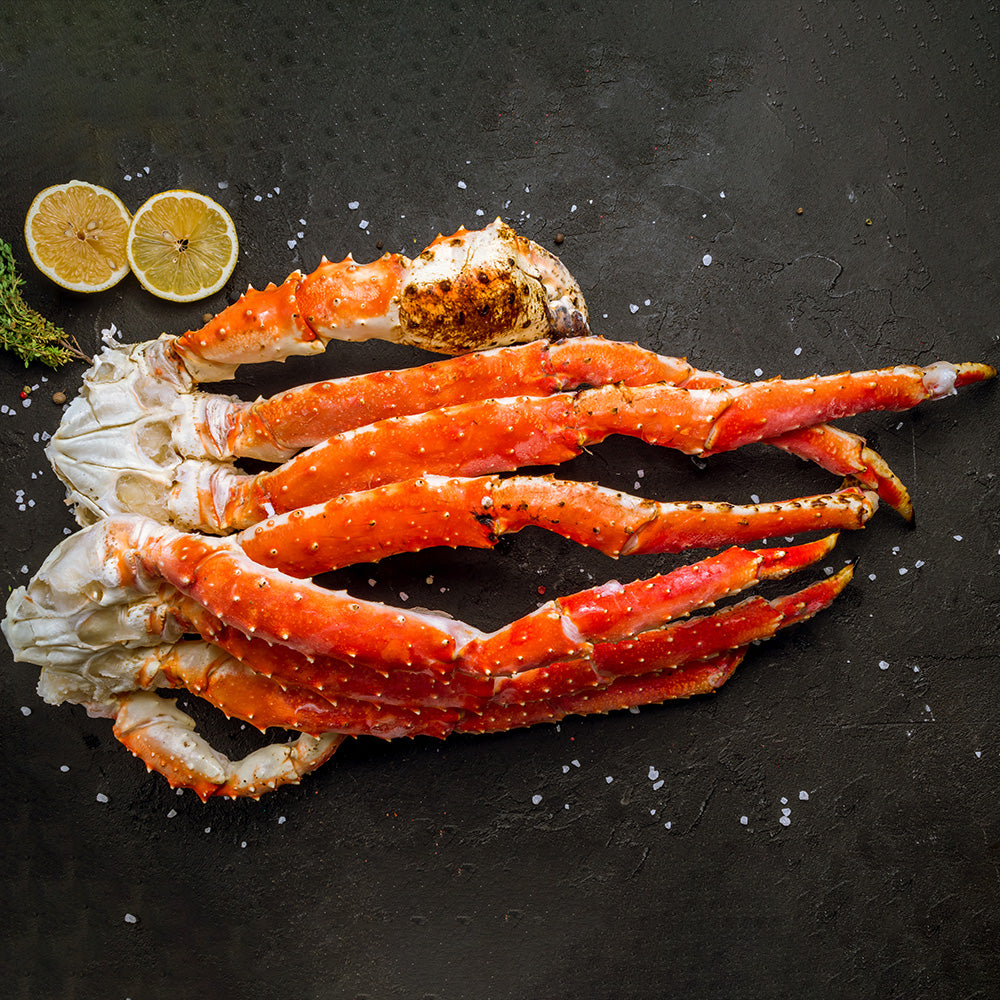
· By Lucas Calderon
Exploring Different Types of Crab Claws
Crab claws are a culinary delight savored by seafood enthusiasts worldwide. Their unique flavor and texture make them a sought-after delicacy.
In this guide, we'll explore the fascinating world of crab claws. We'll delve into the characteristics of different types, from the sweet blue crab to the briny snow crab.
We'll also tackle the question of how many crab legs to serve per person. This is a common query when planning a seafood feast.
Our journey will take us to the realm of jumbo and colossal crabs. These giants of the sea offer an impressive dining experience.
We'll also discuss the best crabs to eat, considering factors like taste, texture, and sustainability.
Join us as we navigate the diverse and delicious world of crab claws. Whether you're a home cook, a foodie, or simply curious, there's something for everyone in this comprehensive guide.
The Allure of Crab Claws: A Culinary Delight
Crab claws stand as a symbol of luxury in the culinary world. Their meat, known for its sweetness and tenderness, offers a succulent experience. The allure lies in their unique combination of texture and flavor.
Across cultures, crab claws are celebrated for their versatility. They can be the star of a dish or a luxurious garnish. Whether steamed, boiled, or grilled, they bring a touch of sophistication.
In regions like the Eastern United States, blue crab claws are especially revered. The meat is tender, with a delicate flavor that is hard to resist. Snow crabs, on the other hand, offer a firmer texture, perfect for those who enjoy a bit more bite.
For those new to claw crab, variety is key. Here are some popular types:
- Blue crab: Sweet, tender, and rich in flavor.
- Snow crab: Briny, with a firm texture.
- King crab: Huge, offering ample, juicy meat.


Beyond taste, crab claws are packed with nutrients. High in protein and omega-3 fatty acids, they are a healthy indulgence. This nutritional profile enhances their appeal, making them a favored choice for health-conscious diners.
Ultimately, crab claws represent more than just a meal. They are a celebration of the sea's bounty, offering a feast for both the palate and the senses.
Comparison Table: Types of Crab Claws
| Crab Type | Size | Flavor Profile | Texture | Price Range | Best For |
|---|---|---|---|---|---|
| Stone Crab | Medium–Large | Sweet, rich, clean | Firm, meaty | $$$$ | Luxury dining, special occasions |
| King Crab | Very Large | Sweet, bold | Thick, hearty | $$$ | Impressive meals, butter dipping |
| Snow Crab | Medium | Mild, briny | Delicate, flaky | $$ | Everyday dinners, crab boils |
| Jonah Crab | Medium | Sweet, slightly salty | Tender, soft | $ | Affordable alternative |
| Blue Crab | Small | Sweet, delicate | Flaky, light | $ | Maryland specialties, crab cakes |
| Dungeness Crab | Large | Sweet, nutty | Tender, juicy | $$–$$$ | West Coast favorites |
Stone Crab Claws
Description
Stone Crab Claws are a Florida delicacy prized for sweet, firm meat and uniquely sustainable practices—only the claw is taken and the crab is returned to regenerate.
Origin
Warm coastal waters of Florida, especially the Keys and Gulf coast (seasonal, Oct–May).
Pairings
Best served chilled with mustard sauce, lemon wedges, and a crisp Sauvignon Blanc.
Unique Features
- Claw-only harvest for natural regeneration.
- Naturally sweet; minimal seasoning needed.
- Highly seasonal and celebratory.

King Crab Claws
Description
Massive, spiky claws packed with rich, hearty meat—an Alaskan showstopper perfect for special occasions.
Origin
Icy northern waters of the Bering Sea and Gulf of Alaska.
Pairings
Steam or grill and serve with melted butter or garlic sauce; pair with Chardonnay or roasted vegetables.
Unique Features
- Red King Crab: largest, most prized; Golden King Crab: slightly smaller, a touch sweeter.
- Colossal size and dramatic presentation.
- Protein-rich, deeply flavorful meat.

Snow Crab Claws
Description
Delicate, mild flavor with a flaky texture—an affordable favorite for boils and shared platters.
Origin
Cold waters of the North Atlantic and North Pacific, notably Alaska and Canada.
Pairings
Excellent for crab boils, bisques, or simple steaming with Old Bay; pair with Pinot Grigio or a light beer.
Unique Features
- Easy to crack and eat—great for groups.
- Sold in clusters ideal for sharing.
- Mild flavor welcomes sauces and soups.

Jonah Crab Claws
Description
Northeastern favorite and a budget-friendly alternative to stone crab, known for mild sweetness and versatility.
Origin
Rocky New England and mid-Atlantic coastlines, from Maine down through Massachusetts.
Pairings
Serve cocktail-style with lemon and cocktail sauce, or on casual seafood platters with a crisp lager.
Unique Features
- Approachable price point without sacrificing flavor.
- Sweet, slightly briny profile—perfect finger food.
- Great for parties and large seafood spreads.
Blue Crab Claws
Description
Iconic to the Chesapeake Bay—small claws with delicately sweet meat beloved in East Coast cuisine.
Origin
Brackish waters of Maryland and Virginia’s Chesapeake region and along the Atlantic seaboard.
Pairings
Ideal for crab soups and crab cakes; enjoy with a crisp lager or off-dry Riesling.
Unique Features
- Centerpiece of Maryland-style crab feasts.
- Distinctly delicate, sweet flavor.
- Cultural staple of Mid-Atlantic seafood.
 Dungeness Crab Claws
Dungeness Crab Claws
Description
West Coast treasure featuring tender meat with a nutty, sweet character.
Origin
Pacific coastline from California through Oregon and Washington, with strong traditions in San Francisco and Seattle.
Pairings
Perfect steamed or folded into pasta, risotto, and chowder; pair with Chardonnay or sparkling wine.
Unique Features
- Larger than blue crab, smaller than king—balanced size and yield.
- Signature nutty sweetness sets it apart.
- A hallmark of West Coast seafood cuisine.
Blue Crab vs Snow Crab: A Flavorful Comparison
Choosing between blue crab and snow crab can be a delightful dilemma. Each offers distinct characteristics that appeal to different tastes.

Blue crabs, known for their sweet, tender meat, are popular in the Eastern United States. Their flavor is delicate and slightly buttery. It's this sweetness that makes them a favorite in crab cakes and Maryland-style crab soups.
Snow crabs, conversely, thrive in colder waters and boast a firm, slightly briny taste. Their meat has a subtle sweetness but leans towards a more robust, savory profile. They are often found in hearty dishes like seafood boils and bisques.
The battle of blue crab vs snow crab extends beyond flavor to texture. Blue crab meat is soft and easy to pull apart. Snow crab provides a firmer bite, adding a satisfying chewiness.
A key factor for many is the ease of preparation and eating. Snow crabs, with their longer legs, are often simpler to crack open. Blue crabs require more skill but reward patience with their rich, sweet meat.
Size considerations can also influence decisions. Snow crabs typically offer more meat due to their larger size, making them ideal for feasts.
Ultimately, the choice between blue crab and snow crab comes down to personal preference. Some prefer the sweet simplicity of blue crab, while others crave the savory, briny flavor of snow crab.
Consider these attributes when choosing:
-
Blue crab: Sweet and tender.
-
Snow crab: Briny and firm.
-
Size: Snow crabs offer more meat.
With these factors in mind, you can select the crab that suits your taste and occasion perfectly.
Size: Choosing Between Jumbo and Colossal Crab Claws
When it comes to crab claws, size can be both a visual and culinary delight. Jumbo and colossal crab claws stand out due to their impressive size and substantial meat yield.
Jumbo crab claws are not just a treat for the eyes. They are packed with a generous amount of meat. This makes them a coveted choice at upscale seafood restaurants. The volume of meat in each claw promises satisfaction in every bite.
Colossal crab claws, on the other hand, take size to the next level. They are often associated with species like the colossal king crab. These claws can provide a hefty portion of delicious, succulent meat. Their size makes them a centerpiece in grand seafood platters.
The appeal of larger crab claws extends to their culinary uses. They are perfect for recipes that demand a significant amount of crab meat without much cracking effort. From creamy dips to lavish salads, they shine in every dish.
Size also allows for a more impressive presentation, whether on a plate or in a buffet setting. The sheer visual impact of these claws can elevate any gathering or celebration.
Key points to consider when choosing:
-
Jumbo claws: Generous meat quantity.
-
Colossal claws: Maximum meat, high visual impact.
-
Culinary flexibility: Perfect for both simple and gourmet dishes.
These attributes ensure that jumbo and colossal crab claws continue to captivate seafood lovers around the world. Their impressive size and delicious taste are unmatched.
How Many Crab Legs Per Person
Planning a seafood feast requires careful consideration of portion sizes, especially when it comes to crab legs. A common question is how many crab legs per person should be served.
The answer depends on various factors, including the type of crab and your guests’ appetites. Typically, 1 to 2 clusters of crab legs per person is a good guideline. This ensures everyone gets a satisfying amount.
Understanding the appetites and preferences of your guests can help fine-tune these numbers. For more substantial eaters, it’s better to aim toward the higher end of the spectrum.
Take into account the type of meal you are offering. If crab legs are the main course, consider serving up to 2 clusters each. For a buffet with diverse options, 1 cluster may suffice.
General Serving Suggestions:
-
Main course: 2 clusters per person.
-
Buffet style: 1 cluster per person.
-
Heavy eaters: Consider extra clusters.
Stone Crab Sizes
- Medium Stone Crab – For the “medium”, for a serving size of two, you get 6-7 claws to the order (per person). This is a great option for an appetizer.
- Large Stone Crab – If you want to jump to the “largest” size for 2 people you will get fewer claws, still 1.5 pounds each per person. Perfect dinner for two!
- Jumbo Stone Crab – Now we are getting into the “WOW” of the dinner party size.
- Colossal Stone Crab – The “as big as your hand” size! An experience on top of enjoying one of Florida’s delicacies.
These guidelines will help ensure that all your guests enjoy a satisfying and delicious meal. Thoughtful planning makes your seafood feast a memorable experience for all.
The Best Crab to Eat: A Guide to Taste and Texture
Choosing the best crab to eat involves more than picking size or availability. Taste and texture are key factors to consider.
Different species offer unique flavors, each pleasing in its own way. Blue crabs, for instance, are favored for their sweet and delicate meat.
In contrast, king crabs boast firm, succulent flesh with a rich flavor. Snow crabs have a slightly briny taste with a fibrous texture that many enjoy.
Determining the best crab also depends on how you plan to serve it. Consider whether you prefer the sweetness of blue crabs in a salad or the robust profile of king crabs as a standalone dish.
Each type of crab offers a unique culinary experience. Your preference for taste and texture will guide your selection in enjoying this seafood delicacy. Whether sweet, rich, or briny, there is a crab that will delight your palate.
The Art of Serving Crab Claws
Serving crab claws is an art that blends skill and creativity. Presentation plays a crucial role in elevating this seafood dish. A carefully arranged platter can transform a simple meal into a feast.
The art of serving crab claws involves understanding their aesthetic and flavor. Each claw can be a centerpiece when presented with complementary sides or sauces. Choose garnishes that enhance both the look and taste of the dish.
Here are some tips for creating an impressive presentation:
-
Arrangement: Neatly arrange claws in a circular pattern for a visually appealing display.
-
Sauces: Offer a variety of dips, such as garlic butter or lemon aioli, to highlight the flavor.
-
Garnishes: Use parsley, lemon wedges, or seaweed for a splash of color and freshness.

Crab & Claw establishments often excel at this, showcasing claws in intriguing and enticing ways. At home, emulate this by paying attention to detail. Serve with flair, and your guests will experience not only deliciousness but also an unforgettable meal. This practice turns crab claws from mere food into a truly artful culinary delight.
Choosing the Right Crab Claws
Sustainability in seafood is vital for environmental health. When selecting crab claws, consider their origin. Responsibly sourced options help maintain marine ecosystems.
Understanding sustainability labels can guide your choices. Certifications ensure that fishing practices protect crab populations and their habitats. Look for labels that indicate environmentally friendly methods.
Seasonal availability also impacts sustainability. Selecting crabs during peak seasons supports population health. It helps balance demand with nature's regenerative cycle.
Here's what to consider when choosing sustainable crab claws:
-
Certifications: Opt for claws with sustainable seafood labels.
-
Origin: Choose local and regionally sourced crabs to reduce your carbon footprint.
-
Seasonal Choices: Buy in-season to support natural cycles and minimize overfishing.
Ethical sourcing benefits the environment and future generations. It preserves crab populations and sustains the rich culinary traditions associated with them. Making informed choices is key to enjoying crab claws with a clear conscience.

Cooking Techniques and Tips for Perfect Crab Claws
Crab claws can be a delight, but cooking them requires care. Different methods bring out distinct flavors and textures. From steaming to grilling, each technique offers something unique.
Steaming is a popular choice for retaining moisture. It enhances the crab’s natural sweetness. Boiling is quicker and results in firmer meat, perfect for salads or cold dishes.
Grilling imparts a smoky flavor, pairing well with bold seasonings. When grilling, marinate the claws in herbs and oil. This process enhances their taste and prevents drying out.
Here are some tips for cooking crab claws perfectly:
-
Steaming: Use a steaming pot and cook for 5-10 minutes until the claws turn bright red.
-
Boiling: Immerse in salted water for 8-12 minutes; consider adding lemon or bay leaves for extra flavor.
-
Grilling: Preheat your grill and cook claws directly over heat for 4-6 minutes.
Proper cooking enhances the pleasure of eating crab claws. Choose your technique based on the occasion and desired flavor profile. These methods ensure a delicious meal every time.
Here's a quick guide to help you decide how to cook each type of crab leg:
| Crab Type | Best Cooking Method | Ease of Eating | Popular Regions |
|---|---|---|---|
| Stone Crab | Served chilled | Very easy | Florida |
| King Crab | Steamed/Grilled | Moderate | Alaska |
| Snow Crab | Boiled/Steamed | Easy | Canada, Northeast |
| Jonah Crab | Steamed/Chilled | Easy | Northeast |
| Blue Crab | Steamed/Fried | Harder (small) | Maryland |
| Dungeness Crab | Steamed/Grilled | Moderate | West Coast |
Pairings and Presentations: Enhancing the Crab Claw Experience
Pairing and presenting crab claws can elevate your dining experience. The right accompaniments highlight the delicate flavors and textures. Consider both beverages and side dishes when planning your meal.
Wine is a classic pairing with seafood. Choose a crisp white wine or a light rosé. They complement the sweetness of the crab without overpowering it.
For side dishes, simplicity is key. Think fresh salads or steamed vegetables. These pairings balance the richness of the crab claws.
-
Wine Pairings: Sauvignon Blanc, Pinot Grigio, or Rosé.
-
Side Dishes: Mixed greens, roasted asparagus, or lemon-butter pasta.
Presentation is vital in enhancing your meal. Arrange claws on a platter with lemon wedges or fresh herbs. This simple touch can make your seafood feast not only tasty but visually appealing.
Conclusion: Embracing the Diversity of Crab Claws
Crab claws offer a diverse and rich culinary adventure. From the sweet blue crab to the impressive colossal king crab, each variety brings something unique to the table.
Embracing this diversity not only expands your palate but also enriches your dining experiences with unforgettable flavors.
Contact Holy Crab for the freshest crabs delivered to your door.








